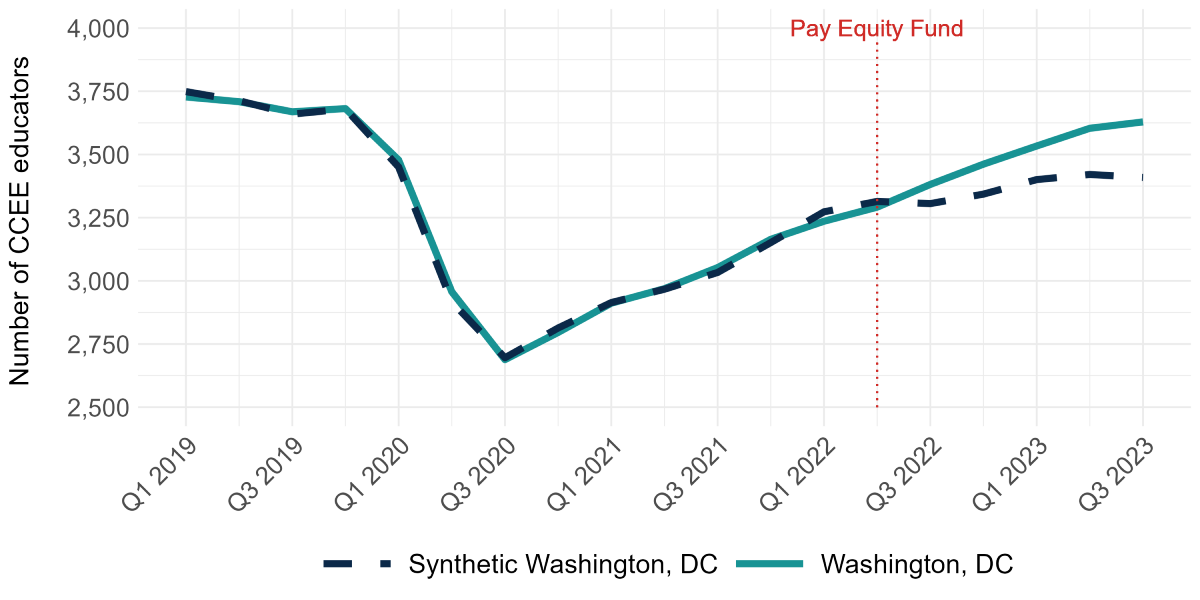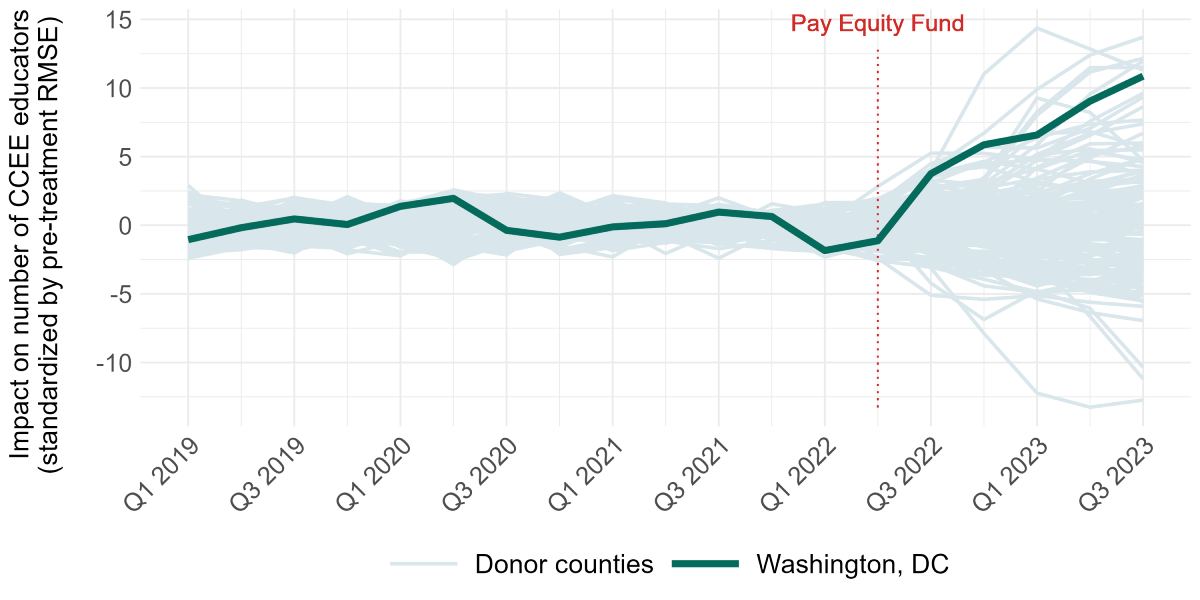Child care and early education (CCEE) educators receive among the lowest wages in the country, and are disproportionately women of color. Low wages have widely been attributed to challenges in recruiting and retaining qualified CCEE educators and to low morale in CCEE settings. A stable and qualified CCEE workforce is the backbone of available and high-quality CCEE for families with young children.
The Early Childhood Educator Pay Equity Fund (PEF) was created in Washington, DC to bring CCEE educator salaries in line with similarly trained and certified educators employed by DC Public Schools. Since the program was launched in fall 2022, the PEF has paid more than $110 million to more than 4,000 CCEE educators, amounting to annual payments from $5,000 to $14,000, depending on educators’ roles and responsibilities. The PEF also supports HealthCare4ChildCare, which has provided access to free or lower-premium health insurance to more than 1,000 educators and other CCEE staff, and their families.
The initial payments from the PEF worked quickly to increase the number of CCEE educators in DC.
In fall 2023, we published the first rigorous evidence on the efficacy of the PEF, examining whether the initial program payments influenced the hiring and retention of CCEE educators in DC. By Q4 2022—just two quarters after the launch of the PEF—the initial payments had increased CCEE employment levels in DC by about 100 additional educators, or about 3 percent. This was the largest positive impact among all U.S. counties in the analysis, suggesting that it was very unlikely to be due to chance. Our finding also affirmed reports from program participants surveyed by colleagues at the Urban Institute. Nearly two in three DC educators indicated that as a result of the program, they now planned to continue working in DC CCEE longer than previously expected. Many directors also reported that the program had influenced their “best” educators’ decisions to stay at their facility and helped them recruit qualified educators to their staff.
The early positive findings on the PEF have drawn national attention, including from other states and localities seeking to implement their own wage supplement initiatives. This attention is due to the innovative nature of this initiative, which is the first program in the nation to enable CCEE educators to receive salaries comparable to public school teachers. The PEF, which is a non-entitlement program, was also the first wage supplement initiative legislated to provide sustainable funding over several years. We partnered with DC Action to continue to study the program to see how the strong initial findings evolved during the second year of the program.
New findings show that the program’s positive initial impact on the number of CCEE educators in DC has grown during its second year of operation.
Using updated federal employment data from the Quarterly Census of Employment and Wages (QCEW), we can now analyze CCEE employment numbers in DC and all other counties in the United States between 2019 and Q3 2023. This contributes three additional quarters of QCEW data that were published by the U.S. Bureau of Labor Statistics since our initial analysis. Combining this additional data with the methods of analysis used in our initial report, we see that by Q3 2023, the PEF payments were associated with an increase of 219 CCEE educators, or nearly 7 percent, over our best estimate of the CCEE employment level in DC without the program.

This analysis uses the QCEW and a synthetic control method to form a weighted combination of counties —a “Synthetic” DC—that is nearly identical to DC in terms of employment levels, wages, and the number of establishments, both within the CCEE sector and across all sectors, in the approximately four-year period prior to the PEF. The initial report includes a more detailed description of how the synthetic control method was implemented in this study and the data used in the analysis. We will share the full set of updated findings in a forthcoming technical report.
This effect was about twice what we initially reported based on data through Q4 2022. Without the PEF, our analysis suggested that the number of CCEE educators in DC would have remained more stagnant, increasing by just 95 workers over this period (shown as the dotted line above). With the program, DC has increased its CCEE workforce by 314 educators during the same span. Over the five quarters following the launch of the PEF, the updated findings suggest it led to an overall effect of 146 additional educators, on average.
These updated findings continue to show that the positive impact of the PEF on CCEE employment in DC is very unlikely to be due to chance.
But how do we know the increases in CCEE employment were because of the PEF and not something else? Are they statistically significant? We conducted a series of “placebo” tests, applying the same synthetic control method to each county in the analysis. Because these counties did not implement the PEF or other similar compensation initiatives over the study period, we would expect smaller differences between each county and its synthetic control. Out of the 145 total counties, DC had the sixth largest overall impact as averaged across the five program quarters. In other words, DC’s impact was larger than that found in about 96 percent of all counties. This suggests this impact is statistically significant at the 4 percent level, which allows us to confidently rule out the possibility that the PEF had no impact on CCEE employment in DC. The significance levels for the impacts at the five individual program quarters range from 2 to 5 percent.

As for DC, the impact for each donor county in a given quarter represents the difference between the number of CCEE educators in that county and the number of CCEE educators in its synthetic control. The impacts for DC and for each donor county are standardized according to the “root mean squared error” (RMSE), a metric that corrects for donor counties that were poorly matched to their synthetic control.
These additional findings on the benefits of the PEF contribute to the growing evidence base surrounding its impacts and can inform policy and funding discussions.
The PEF marks a shift in U.S. CCEE funding through its broad-scale alignment of educator compensation with that of public school teachers. The updated findings from our ongoing research into the efficacy of the program reinforce its potential as a tool for supporting the workforce that provides CCEE services to families with young children in Washington, DC. Policy and funding discussions surrounding the PEF should be informed by the growing evidence base on its effectiveness throughout its first two years of operation. We encourage policymakers and community leaders to consider these findings as they make important decisions about the future of the program.



